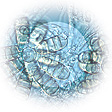Surface Sampling (Dust)ObjectiveTo determine whether the surface sampled indicates a skewing in the normal distribution of spore types, and also note for "marker" genera, which may indicate indoor mold growth. Note: A dust sample can be analyzed by direct microscopic examination or by culturing. Both have their own advantages and disadvantages. It is usually recommended that both culture and direct examination be done on the sample as either of the analysis done alone may result in an inaccurate characterization of the dust sampled. If only one method of analysis is to be used, usually a culturable analysis is the best choice. Advantages and DisadvantagesAdvantagesDust samples are felt to relate to the history of what is in the air. Dust sample for a direct examination may be analyzed immediately. DisadvantagesThe results are dependent upon the sampling method and results may be difficult to interpret. EquipmentDust filter cassette. Vacuum pump. Sampling protocolsControl as many sampling variables as possible including the time of vacuuming, the amount of pressure applied, the size of the area sampled, the direction of sampling, and the equipment used. Sample from areas that are unlikely to be affected by foot traffic or other sources of fungi that are not from the air. Corners of rooms are often good areas. Try to get at least a teaspoon of dust and record the area vacuumed. ShippingThere are no special shipping requirements for fungal analysis (dust samples for allergen analysis should be sent with a cold back via an overnight courier). |
 |